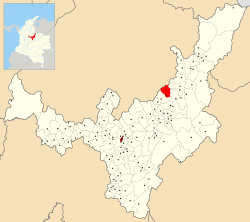Tutazá facts for kids
Quick facts for kids
Tutazá
|
||
|---|---|---|
|
Municipality and town
|
||
|
||

Location of the municipality and town of Tutazá in the Boyacá Department of Colombia
|
||
| Country | ||
| Department | Boyacá Department | |
| Province | Tundama Province | |
| Founded | 6 October 1849 | |
| Area | ||
| • Municipality and town | 135 km2 (52 sq mi) | |
| • Urban | 35 km2 (14 sq mi) | |
| Elevation | 2,700 m (8,900 ft) | |
| Population
(2015)
|
||
| • Municipality and town | 1,890 | |
| • Density | 14.00/km2 (36.26/sq mi) | |
| • Urban | 195 | |
| Time zone | UTC-5 (Colombia Standard Time) | |
| Website | Official website: http://www.tutaza-boyaca.gov.co/ | |
Tutazá, also spelled Tutasá, is a small town and a municipality in Colombia. It is located in the Boyacá Department, which is a part of Colombia. Tutazá is found in a subregion of Boyacá called the Tundama Province.
The town shares its borders with other municipalities. These include Belén, Paz de Río, Sativasur, and Sativanorte in the Boyacá Department. It also borders Onzaga and Coromoro, which are in the Santander Department.
A Look Back: The History of Tutazá
Before the Spanish arrived in Colombia, Tutazá was a special place. It was ruled by a leader called a cacique. The cacique of Tutazá was named Tutazúa. He was loyal to another important leader, Cacique Tundama, who lived in a city now known as Duitama.
The name Tutazúa comes from the Chibcha language. This was the language spoken by the Muisca people. In their language, Tutazúa means "Son of the Sun."
Even though missionaries visited the village as early as the 1600s, Tutazá was officially founded much later. The official founding date was October 6, 1849. A very famous person, Simón Bolívar, who helped many South American countries gain independence, visited Tutazá on July 18, 1819.
What People Do in Tutazá: The Economy
The main ways people make a living in this small village are through farming and raising animals.
- Farming: Farmers in Tutazá grow many different crops. These include potatoes, maize (corn), beans, peas, barley, and wheat.
- Livestock Farming: People also raise animals, which is known as livestock farming. This is an important part of the local economy.
See also
 In Spanish: Tutazá para niños
In Spanish: Tutazá para niños


